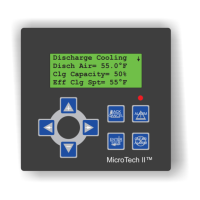Page 16 of 32 OM 750
Cant Cool State (state number C)
The Cant Cool state is a “non-normal” state that the UVC can go into
when Cool mode is active. The Cant Cool state typically becomes
active when primary (economizer) and secondary (compressor) cooling
are not available (or they are disabled), an IAT, DAT or OAT sensor
failure during the Cool mode can also cause the UVC to make the Cant
Cool state active.
Transition (Econ ≠ Available AND Mech Cooling ≠ Available)
into State OR
(Mech Cooling ≠ Available)
Operation When the Cant Cool state becomes active, no cooling
within State will take place.
The UVC will remain in this state until one of the
transition out conditions become true, or until one of
the super state transition out conditions becomes true.
Transition (Econ = Available AND Mech Cooling ≠ Available)
out of State OR
(Econ ≠ Available AND Mech Cooling = Available)
Figure 16. Mech State Operation (Occupied Mode and Auto Fan)
Transition (Econ ≠ Available)
into State OR
(Econ ≠ Available AND Mech Cooling = Available)
Operation When the Mech state becomes active, the UVC will
within State use the unit’s mechanical cooling capabilities (see
Compressor Operation) as needed to maintain the
effective cooling setpoint (see Space Temperature
Setpoints). The UVC will monitor the DAT to ensure
it does not fall below MCLL (see Mechanical Cooling
Low Limit) setpoint. The CO
2
demand controlled
ventilation function will be active, if the unit is equipped
for CO
2
control (see CO
2
Demand Controlled
Ventilation), and the OAD will be adjusted as needed
to maintain the CO
2
setpoint.
The UVC will remain in this state until one of the
transition out conditions become true, or until one of
the super state transition out conditions becomes true.
Transition (Econ = Available)
out of State OR
(Mech Cooling ≠ Available)
Mech State (state number 2)
The Mech state is a “normal” state that the UVC can go into when Cool
mode is active. The Mech state is typically active in the Cool mode
when primary cooling (economizer) is not available and secondary
cooling (compressor) is available.
DA Heat State (state number 4)
The DA Heat state is a “normal” state that the UVC can go into when
Cool mode is active. The DA Heat state is typically active when reheat
is required to maintain DATS while maintaining the required OA
damper position. The DA Heat state can also be active if the optional
CO
2
DCV feature is provided and CO
2
levels are high, requiring the OA
damper to open beyond what would be required for economizer
cooling.
Transition (Space = High CO2 OR DAT < VCLL)
into State OR
(Low Limit Timer = Expired AND OAD ≠ Alarm)
Operation When DA Heat state is active, then the UVC will use
within State the unit’s heating capability as needed to maintain the
VCLL setpoint. The Heat Timer (3-minutes fixed)
will begin counting. The CO
2
demand controlled
ventilation function will be active, if the unit is equipped
for CO
2
control (see CO
2
Demand Controlled
Ventilation), and the OAD will be adjusted as needed
to maintain the CO
2
setpoint.
The UVC will remain in this state until one of the
transition out conditions become true, or until one of
the super state transition out conditions becomes true.
Transition (Space ≠ High CO
2 AND Heat PI = Saturated Low
out of State AND DAT > VCLL)
OR
(Heat PI = Saturated High AND Heat Timer = Expired)
Notes:
The OAD is considered to be in “alarm” when the OAD is forced below
the active minimum position in the Low Limit state. This is not an actual
unit “alarm” or “fault” condition, but only a condition used for the purpose
of transition arguments.
Low Limit State (state number F)
The Low Limit state is a “non-normal” state that the UVC can go into
while Cool mode is active. The Low Limit state typically follows the
DA Heat state when the UVC has reached 100% heat and still cannot
maintain VCLL.
Transition (Heat PI = Saturated High AND Heat Timer = Expired)
into State OR
(Heat = Available AND Low Limit = Active)
Operation When the Low Limit state becomes active, the Low
within State Limit PI-loop will override the OAD minimum position
(see Outdoor Air Damper Operation) and adjust the
OAD toward closed as necessary to maintain the DAT
setpoint (see Discharge Air Temperature Setpoint).
The Low Limit Timer (10-minutes fixed) will begin
counting.

